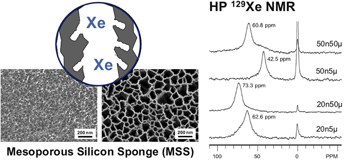Article contents
Hyperpolarized 129Xe nuclear magnetic resonance study of mesoporous silicon sponge materials
Published online by Cambridge University Press: 08 May 2017
Abstract

Mesoporous silicon sponge (MSS) is considered as a promising anode material for lithium ion batteries because of its preformed meso/macro porous structures that can accommodate large volume expansion during the lithiation process and its superior electrochemical performance. Temperature dependent hyperpolarized (HP) 129Xe NMR was applied to characterize the structure and porosity of MSS materials with varying pores and particle sizes. Our results reveal irregular pore structures with the presence of micropores inside the larger meso/macropore channels and each MSS material has its own characteristic pore environment with a varying degree of nonuniformity and connectivity of pores. This study demonstrates that HP 129Xe NMR is a potentially useful tool for providing a fingerprint of the structure and connectivity of the pores for each material, complementary to other characterization techniques.
- Type
- Articles
- Information
- Copyright
- Copyright © Materials Research Society 2017
Footnotes
These authors contributed equally.
Contributing Editor: Paolo Colombo
References
REFERENCES
- 3
- Cited by



